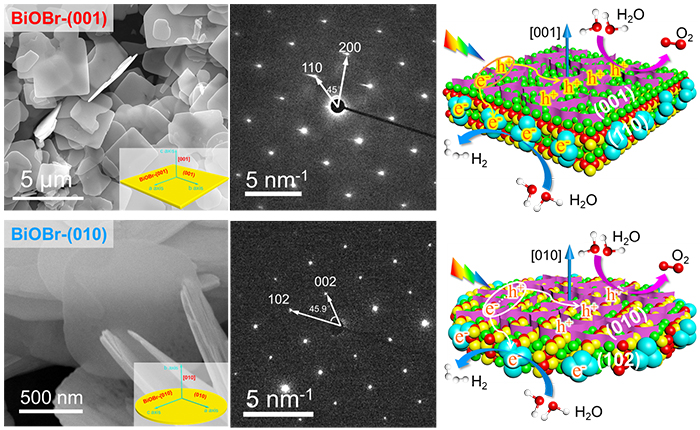They found that the photocatalytic activity of semiconductor photocatalysts was not directly correlated to the highly exposed facets, and it intrinsically originated from the photogenerated charge separation properties between the highly exposed crystal facets and co-existing crystal facets.
The spatial charge separation between different crystal facets of semiconductors has been widely proven to be an effective strategy to boost the photocatalytic activity.
Although many studies attribute the difference in photocatalytic activity to the high exposure of active crystal facets, some conclusions on the highly active crystal facets for photocatalytic reactions are contradictory, hindering the understanding about the influence of crystal facet and morphology on the photocatalytic mechanism.
Spatial separation of photogenerated electrons and holes between different facets of BiOBr nanocrystals. (Image by SHI Ming and LI Rengui)
In this study, based on the research of spatial charge separation between different facets, the researchers took the typical bismuth oxybromide (BiOBr) semiconductor as the model, and synthesized two types of BiOBr nanocrystals exposeing with representative (001) and (010) facets, respectively.
They found that the intrinsic photocatalytic activities of BiOBr were not directly owing to the highly exposed facets, but dominantly determined by the co-exposing facets, although the proportion ratio of the co-exposing facets was not high.
The co-existing crystal facet directly determines the oxidation and reduction properties of the highly exposed crystal facet in the photocatalytic reactions, providing the possibility to modulate the properties of different exposed facets for semiconductors. Thus, the spatial charge separation between the highly exposed crystal facet and co-exposing facets occurs effectively.
It is the spatial charge separation between different facets that renders the reduction and oxidation reactions to separately occur onto the dominate facet and the co-exposing facet with different reaction rates, and the matching of oxidation and reduction reactions determines the intrinsic reactivity of BiOBr nanosheets.
This work unravels the intrinsic facet-dependent photoreactivity of semiconductors and systematically elucidates the reason why the photocatalytic activity depends on crystal facet of semiconductors, which will shed light on the understanding the mechanisms of photocatalytic solar energy conversion systems.
This work was supported by the National Natural Science Foundation of China, Strategic Priority Research Program of the Chinese Academy of Science and Key Research Program of Frontier Sciences of the Chinese Academy of Sciences.







